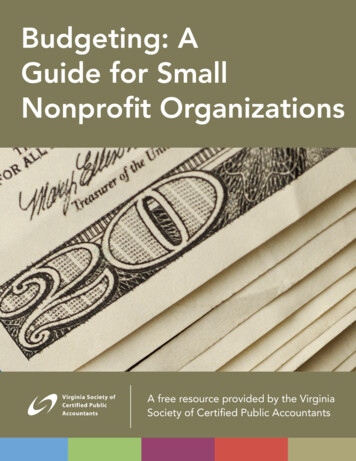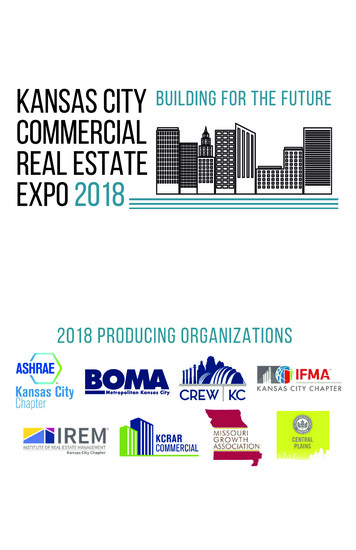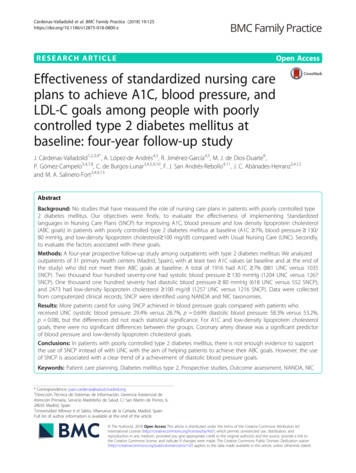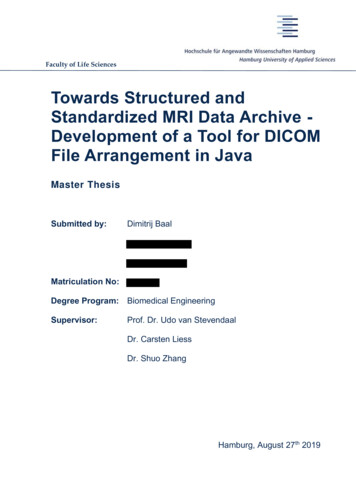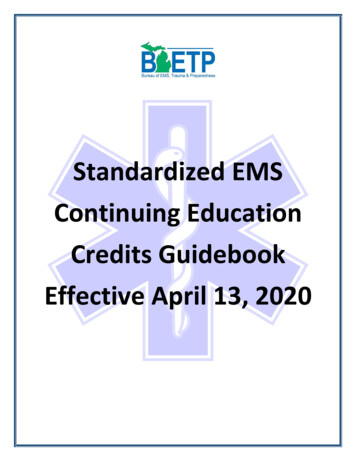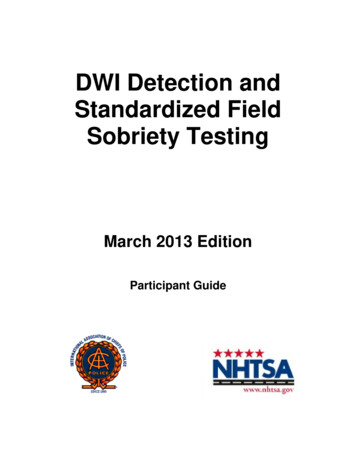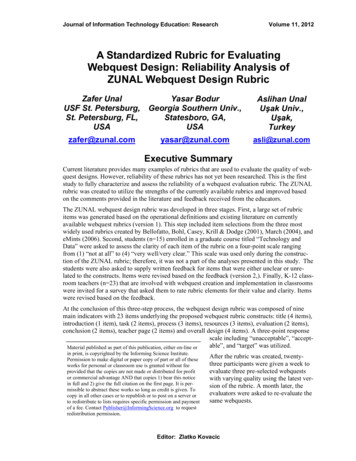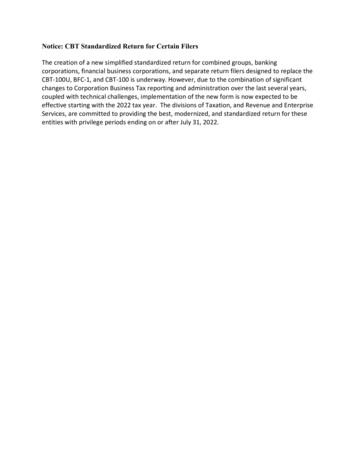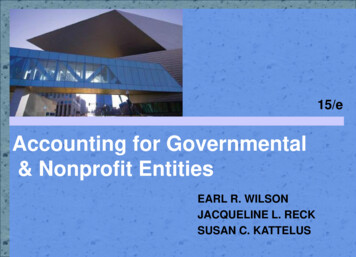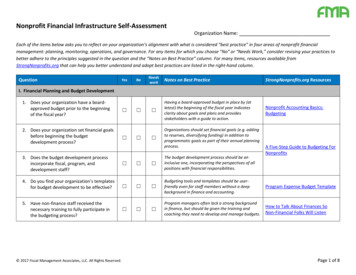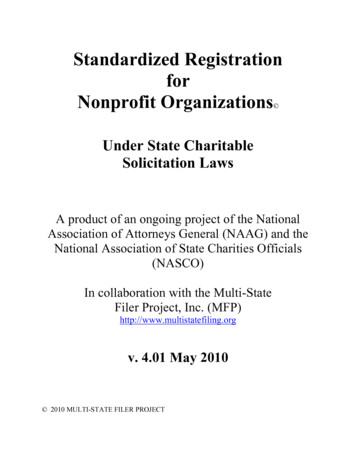
Transcription
Standardized RegistrationforNonprofit Organizations Under State CharitableSolicitation LawsA product of an ongoing project of the NationalAssociation of Attorneys General (NAAG) and theNational Association of State Charities Officials(NASCO)In collaboration with the Multi-StateFiler Project, Inc. (MFP)http://www.multistatefiling.orgv. 4.01 May 2010 2010 MULTI-STATE FILER PROJECT
NAAG/NASCO Standardized ReportingURS v. 4.01 Introduction Pg. 1Introduction & ContentsWhy must my organization “register?”The simple answer is “it’s the law.” Typically, states exercise regulatory authority over nonprofitsbased on one (or both) of two premises: the nonprofit is physically “present” in the state (e.g., has an office, owns real estate, or conducts program activities) or the nonprofit raises funds in the state.In either case, a state may require the nonprofit to “register”, that is, to provide identifying information about the nonprofit and its operations. It is the latter premise for registration -- raising funds -that provides the impetus for the Unified Registration Statement and the movement for standardized reporting in general. Organizations of any size and any means may find that raising funds from the public -even when conducted modestly from a single location -- will give rise to regulatory obligations to multiple states.In fact, today most states regulate fundraising. They do so through statutes -- usually called “solicitation laws” -- that are primarily concerned with the solicitation of charitable contributions from thegeneral public. The centerpiece of most of the regulatory schemes is comprehensive reporting, by nonprofits and by the outside fundraising firms and consultants they employ.What is “registration?”Compliance reporting under solicitation laws is divided into two pieces: (1) registration, whichprovides an initial base of data and information about an organization's finances and governance; and (2)annual financial reporting, which keeps the states apprised about the organization's operations with anemphasis on fundraising results and practices. Typically, states require both registration (at least an initialregistration) and annual financial reporting.With forty jurisdictions regulating in this manner, there is inevitably little consistency of approach.Some states have one-time registration; others require annual renewal of registration; some will requiresubmission of every common governance and financial document; others make do with just an IRS Form990; and so forth. But each has its own registration form (or forms) and, until the advent of the URS, required its submission, verbatim.PLEASE TAKE SPECIAL NOTE: The URS and this packet are designed for registration only.For many states, the URS cannot be used to fulfill annual financial reporting requirements. A projectis underway to produce a standardized format -- like the URS -- for annual financial reporting (see below). For now, the URS is the sole device for standardized, multi-state filing and it applies only to registration and registration renewal (which may be required yearly but, we say again, may be distinct fromannual financial reporting).Which nonprofits must register (and when)?Generally, any nonprofit conducting a charitable solicitation within the borders of a state, by anymeans, is subject to that state’s law and is therefore required to register (and must do so before soliciting).Also, generally, the operative terms “charitable” and “solicitation” are defined very broadly and could include, for example, a website posting by an environmental organization inviting contributions from thepublic.In other words, the soliciting organization need not be a “charity” in a strict sense nor have anyphysical presence of any kind in the state. So, a letter, phone call, or newspaper ad requesting financialsupport from a state's residents is enough, in the unchallenged legal opinion of the states, to trigger thecoverage of (i.e., give jurisdiction to) that state's solicitation law.However, Internet fundraising does not neatly conform to existing models -- neither jurisdictionalmodels nor fundraising models. The ultimate jurisdictional question, roughly put, is “Has someone purposefully directed a charitable solicitation to a resident of our state?” A “yes” provides a state with a rationale for exercising jurisdiction. The question and answer get very fuzzy in cyberspace.The National Association of State Charity Officials (NASCO), recognizing the challenges posedfor both nonprofits and regulators, has developed a protocol to aid all concerned (see the “Charleston
NAAG/NASCO Standardized ReportingURS v. 4.01 Introduction Pg. 2Principles” at www.nasconet.org). The protocol will guide state officials in exercising jurisdiction overInternet transactions and it will help nonprofits determine whether (and when) their Internet fundraisingactivity will subject them to solicitation law registration and reporting.Against this framework of all-inclusiveness is a patchwork of exclusions from coverage. Theseare the product of each state's constitutional and political considerations. Either through exemption fromregistration requirements or out-and-out exclusion from the law, each state excuses some nonprofits fromregistering. For example, every state grants an exemption (or exclusion) to “religious organizations,” asthe term is respectively defined, and most have exemptions for colleges and universities or for organizations raising only small amounts (say, under 5,000). Please see the Appendix for details on each state.Significantly, technical compliance with any state's registration law requires initial registrationbefore the first solicitation has been directed into the state. The fact remains that many nonprofits havenot done the necessary legal homework before launching fundraising campaigns. If your nonprofit is oneof these, you should be very concerned. But you should not be deterred from going ahead with registration because you fear you are breaking a law already and it's too late to comply.Failure to register before soliciting is a violation of law and could subject the organization (and insome circumstances, its officers or directors) to whatever sanctions (e.g., a substantial fine) exist in eachstate's law. But, the states generally wish to encourage honest efforts to comply with registration laws andtend to employ sanctions only when enforcement officials deem it necessary. So, an organization able todemonstrate its good faith which promptly registers after discovering its obligation (albeit tardily) standsa good chance of avoiding or minimizing sanctions. The bottom line: registration is the law and youmust comply as soon as possible.What is the Unified Registration Statement?The URS represents but a single part of an effort to consolidate the information and data requirements of all states requiring registration. Organized by the National Association of State Charities Officials and the National Association of Attorneys General, the project’s aim is to standardize, simplify, andeconomize compliance under the states' solicitation laws.The URS effort consists of three phases: (1) compiling an inventory of registration informationdemands from all states, (2) producing a format (or form) which incorporates all (or most) of these demands, and (3) encouraging the states to accept this “standardized” format as an alternative to their ownforms. The effort is dynamic and ongoing, now represented by version 4.0 of the URS, which is acceptedby thirty-seven of the forty jurisdictions requiring registration. Reflecting this dynamic, the URS will beupdated continually by way of its website (http://www.multistatefiling.org/). See Item #6 in the “Reminders” section (URS Instructions, pg. 4) for more information on URS packet updates.How do you use the URS?The URS is an alternative to filing all of the respective registration forms produced by each of thecooperating states. In those states, a registering nonprofit may use either the state form or the URS. Thus,the URS proves most useful to nonprofits soliciting regionally or nationally and, therefore, subject to theregistration laws of multiple states. But the URS may be used by any nonprofit that is registering in a stateaccepting it.Conceptually, the process is simple. You fill out the URS by following its accompanying instructions; photocopy the completed URS (with state-specific items, including signature lines, left blank); fillin any state-specific items; execute (i.e., sign with or without notary) according to each state's requirements; collect and attach the specified governance (for initial filings) and other documents; write a checkfor the prescribed registration fee (if any); and mail the package, covered by the URS, to the respectivestate's administering agency. Please see the Appendix for a listing of state-specific items, necessary documents, fee for filing, and address of each state’s administering agency. Important note: do NOT sendcompleted URS forms to the Multi-state Filer Project; we do not process these. They must go to eachstate in which you are registering.
NAAG/NASCO Standardized ReportingURS v. 4.01 Introduction Pg. 3What's in this packet?The URS is presented here along with additional materials and information. The goal is to enablemost users to complete their registrations (for URS states) without the need to acquire information or materials outside this packet. Please read the following description of the packet's contents to learn what'shere and where to find it:* URS (3 pgs) and Instructions (4 pgs.) – Only one copy of the URS is provided with this packet. Make aback up photocopy of the blank form before you begin work. Note that the submitted URS will be considerably longer than the 3 pages of the form due to several required attachments. Please consult the instructions while filing out the URS for information on how to answer each question.* Supplementary Forms (22 forms/instructions from 15 jurisdictions) – A number of states wished to cooperate with the URS effort but found it necessary for legal or other reasons to request information and/oroffer instruction on forms designed to supplement the URS. For those states, the respective supplementaryform or information must accompany the URS.* Appendix (15 pgs.) – Provides state-by-state filing details for each of the thirty-six cooperating statesand DC. Please closely attend to the following notes for helpful information about the Appendix:(1) The Exemptions entries are NOT verbatim from the laws. If you believe your organization may be exempt in one or more states, be cautious and refer to the law (See Governing law in the Appendix for citation), regulations, and/or applicable form from the respective states.(2) Due date refers to the day that the first filing subsequent to the initial registration is due (initial registration is required before solicitation begins). This subsequent filing may be termed a “registration renewal” or an “annual financial report.” See (7), below, for information on due dates for annual financialreports.(3) Fund Raiser contracts refer to the actual contractual documents establishing your relationship withoutside fundraising professionals described in URS Item 20. A “yes” here in a state's entry means youmust copy and submit all such contracts, along with the URS, to that state. Note too that subsequent contracts may have to be submitted (either when entered into, with registration renewal, or as part of requiredannual financial reporting).(4) Your Certificate of Incorporation, Bylaws, and IRS Determination Letter (official letter from InternalRevenue Service establishing federal tax-exempt status) are one-time submissions with initial registration.Unless amended after initial registration, they need not accompany renewal filings.(5) In obvious contrast, Audit and IRS Form 990 change from year to year. A “yes” means that the mostrecently completed versions must be submitted with the URS. Note that while a state (e.g., Oregon) maynot require either for purposes of registration, it might require the current version of either or both as partof annual financial reporting. Also note that states articulate the need to submit an audit very differently –pay close attention to the requirements listed in the Appendix to the URS, as the actual terminology ofeach state is used for this entry.(6) Information about registration for States not yet accepting the URS is included.(7) Basic information on annual financial reporting (and/or registration renewal) for all URS states is included in a separate section. Although the URS has not been officially sanctioned for use in fulfilling annual financial reporting/renewal requirements, the information is provided here to help filers understandand coordinate their reporting obligations.* Help (3 pgs.) – Provides several aids for filers, itemized below:(1) The Checklist recapitulates much of the Appendix in an easy-to-read, yes-no format. It serves as a useful tool when, for example, you are submitting multiple registrations and need to be assured that eachstate receives the necessary components.(2) Changes to the URS detail changes to each version of the URS packet since v. 2.00.(3) Site List provides sources for printed copies of the URS packet.
NAAG/NASCO Standardized ReportingURS v. 4.01 Introduction Pg. 4What's next for the Standardized Reporting Project?In every sense, both the URS and the Project are a work in progress. There are four componentsto reporting under the solicitation laws: registration for nonprofits, annual reporting for nonprofits, registration for outside professionals, and annual reporting for outside professionals. Although work on theadditional four components is under way, the URS (nonprofit registration) is the sole product in service.While the “standardized” approach implies continual change, even the threshold work on the URSis not complete. For example, page 12 of the Appendix lists the three remaining states that, for one reason or another, have not yet chosen to participate by accepting the URS. Neither the URS nor any subsequent products will achieve maximum utility until all states are cooperating.Version 4.01 of the URS packet contains numerous refinements, many of them the product of usercomments. Consequently, your feedback is very important. Please direct any comments you may haveabout suggested improvements (or about errors you believe you've discovered) to the URS, its instructions, or to the accompanying materials to:Karin K. GoldmanCharities Trusts BureauNew York State Attorney General Office120 BroadwayThird floorNew York, NY 10271-0002(212) 416-8060chnkkg@oag.state.ny.usand/orRobert TignerGeneral CounselMulti-State Filer Project1612 K Street, NWSuite 510Washington, DC 20006-2802(202) 463-7980Note: Please do not send the Multi-State Filer Project your completed URS form. These go directlyto the state(s) you are registering in. 2010 M U L T I - S T A T E F I L E R P R O J E C T
NAAG/NASCO Standardized ReportingURS v. Pg1Unified Registration Statement (URS) for Charitable Organizations (v. )Initial registrationRenewal/UpdateThis URS covers the reporting year which ended (day/month/year)Filer EINStateState ID1. Organization’s legal nameIf changed since prior filings, previous name usedAll other name(s) used2. (A) Street addressCityCountyStateZip Code(B) Mailing address (if different)CityCountyStateZip Code3. Telephone number(s)Fax number(s)E-mailWeb site4. Names, addresses (street & P.O.), telephone numbers of other offices/chapters/branches/affiliates (attach list).5. Date incorporated State of incorporationFiscal year end: day/month6. If not incorporated, type of organization, state, and date established7. Has organization or any of its officers, directors, employees or fund raisers:A. Been enjoined or otherwise prohibited by a government agency/court from soliciting?B. Had its registration denied or revoked?YesNoYesNoC. Been the subject of a proceeding regarding any solicitation or registration?YesNoD. Entered into a voluntary agreement of compliance with any government agency or in a case before a court oradministrative agency? YesNoE. Applied for registration or exemption from registration (but not yet completed or obtained)?F. Registered with or obtained exemption from any state or agency?G. Solicited funds in any state?YesYesYesNoNoNoIf “yes” to 7A, B, C, D, E, attach explanation.If “yes” to 7F & G, attach list of states where registered, exempted, or where it solicited, including registering agency,dates of registration, registration numbers, any other names under which the organization was/is registered, and the datesand type (mail, telephone, door to door, special events, etc.) of the solicitation conducted.No8. Has the organization applied for or been granted IRS tax exempt status? YesOR date of determination letter.If yes, date of application. Are contributions to the organization tax deductible?If granted, exempt under 501(c)YesNo
URS v. NAAG/NASCO Standardized Reporting9.Has tax exempt status ever been denied, revoked, or modified?Pg2NoYes10. Indicate all methods of solicitations:TelephonePersonal ContactRadio/TV AppealsMailNewspaper/Magazine AdsOther(s) (specify)Special Events11. List the NTEE code(s) that best describes your organization,,12. Describe the purposes and programs of the organization and those for which funds are solicited (attach separate sheet ifnecessary).13. List the names, titles, addresses, (street & P.O.), and telephone numbers of officers, directors, trustees, and the principalsalaried executives of organization (attach separate sheet).14. (A) (1) Are any of the organization’s officers, directors, trustees or employees related by blood, marriage, or adoption to:(i) any other officer, director, trustee or employee OR (ii) any officer, agent, or employee of any fundraisingprofessional firm under contract to the organization OR (iii) any officer, agent, or employee of a supplier orNovendor firm providing goods or services to the organization? Yes(2) Does the organization or any of its officers, directors, employees, or anyone holding a financial interest in theorganization have a financial interest in a business described in (ii) or (iii) above OR serve as an officer, director,Nopartner or employee of a business described in (ii) or (iii) above? Yes(If yes to any part of 14A, attach sheet which specifies the relationship and provides the names, businesses, andaddresses of the related parties).(B) Have any of the organization’s officers, directors, or principal executives been convicted of a misdemeanor or felony?No(If yes, attach a complete explanation.) Yes15. Attach separate sheet listing names and addresses (street & P.O.) for all below:Individual(s) responsible for custody of funds.Individual(s) responsible for distribution of funds.Individual(s) responsible for fund raising.Individual(s) responsible for custody of financial records.Individual(s) authorized to sign checks.Bank(s) in which registrant’s funds are deposited (include accountnumber and bank phone number).16. Name, address (street & P.O.), and telephone number of accountant/auditor.NameAddressCityStateZip CodeTelephoneMethod of accounting17. Name, address (street & P.O.), and telephone number of person authorized to receive service of process. This is a statespecific item. See instructions.NameAddressCityStateZip CodeTelephone
URS v. 0 NAAG/NASCO Standardized ReportingPg318. (A) Does the organization receive financial support from other nonprofit organizations (foundations, public charities, combinedNocampaigns, etc.)? YesNo(B) Does the organization share revenue or governance with any other non-profit organization? Yes(C) Does any other person or organization own a 10% or greater interest in your organization OR does your organizationNoown a 10% or greater in
Standardized Registration for . Also, generally, the operative terms “charitable” and “solicitation” are defined very broadly and could in-clude, for example, a website posting by an environme

